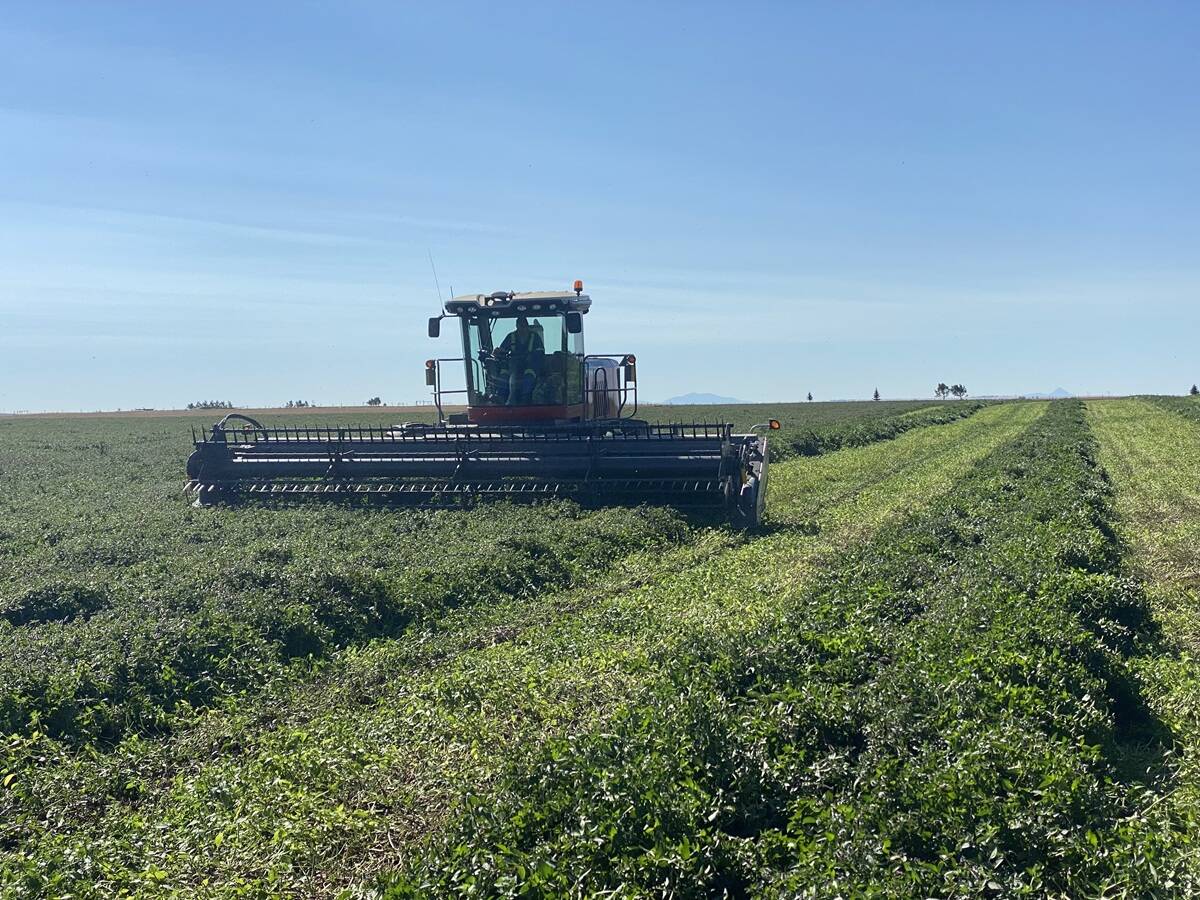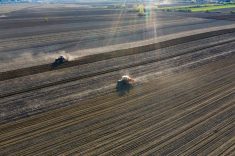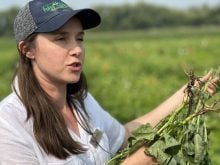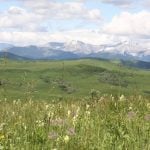Wilf Pennell is a Saskatchewan farmer looking at whether variable rate seeding can increase yield on less productive sites in a field.
After only a couple years of trying the new treatment on part of his Kamsack-area farm in east-central Saskatchewan, Pennell isn’t ready to draw any firm conclusions. But increasing the seeding rate of wheat and barley on some less productive sites in 2010 appears to have produced higher or more consistent yields. He is willing to give it another try in 2011 to see if production continues to improve.
Read Also

How a southern Alberta farm maintains mint condition
An estimated 25 per cent of North America’s mint oil is now the product of a southeastern Alberta farming business, but don’t get the idea that commercial mint production is a job for the faint of heart.
Pennell is one of several farmers across Western Canada looking at variable rate seeding to help improve, or at least even out, crop maturity and yields. Working with Farmer’s Edge consulting services, he adopted variable rate fertilizer application a couple years ago, and he has since tried two approaches to seeding in 2009 and 2010.
CHANGED THINKING
Pennell says while the concept of variable rate fertilizer is to apply more fertilizer to the more productive areas of a field, he’s modified his thinking when it comes to variable rate seeding, mainly because of the soil type on his farm.
“In 2009, I wasn’t really impressed with the results of variable rate fertilizer,” says Pennell. “I have a lot of heavy clay soil, even on hillsides, and the first year I was probably more concerned about saving money on fertilizer, so I applied less fertilizer on these lower produceing heavy clay hills and put more on the better producing sites. I may have saved some on fertilizer, but I didn’t think the overall yields were as good as they should have been.
“I think when you are doing this, it is important to know your land. I have some sandy soils that aren’t very productive and I don’t think it is worthwhile putting extra inputs in those areas. But on these heavy clay soils, it is still good soil, but it was blown and eroded in the 1930s and ’40s. But I think if it has the nutrients it can still produce.”
So Pennell changed his approach in 2010. With five or six production zones in each field he decided to increase the fertility rates on the less productive heavy clay hills and also increase the seeding rate.
“It was only one year and we had lots of rain, but we had a good stand on those so-called poorer sites, (and) we had a more even maturity and yield across the field,” he says. “My thinking is if we put more inputs into these poorer heavy clay sites that over the next four or five years they will get built up, and their productivity will improve.”
GRADUAL ADOPTION
Pennell crops about 6,000 acres of wheat, barley, oats, canola, flax and some pedigreed forage seed. He’s introduced variable rate technology to his farm gradually. He did a few hundred acres in 2009, had planned to do about 1,500 acres in 2010, but due to excessive moisture only applied VRT to about 800 acres. In 2011 he plans to use VRT over about half the farm.
Last year, he increased the seeding rate by about 15 to 20 per cent on about 300 acres each of wheat and barleyt. “I don’t think there are any formulas for the variable rate seeding, so we just went with about 15 per cent more seed to see what happened and we can adjust from there.
“I believe the variable rate fertilizer makes sense, and hope to apply that to the whole farm over the next couple years,” says Pennell. “I’m not sure about the variable rate seeding. I was impressed with the overall results from last year, but I think we need to look at it for another couple years to see if it makes a difference.”
With variable rate fertilizer, Pennell prefers to have only a couple blends of fertilizer for the whole farm and adjust the rates. Overall, in 2010 he probably used about the same amount of fertilizer as in past years, but with VRT adjusted the distribution. With variable rate seeding on the wheat and barley acres, he figures he used slightly more seed.
While variable rate fertilizer generally places more emphasis on increasing the productivity of the most productive soils, other farmers and crop consultants working with farmers are looking at variable rate seeding as a tool for increasing production on less productive areas of a field.
CORN AND CANOLA
Near Morden, Man., Garrett Darby, a Farmer’s Edge consultant and a farmer, has tried variable rate seeding with both corn and canola. Darby figures the approach to variable rate seeding will vary depending on the crop, soil conditions and other factors.
With corn, for example, where variable rate seeding has been tried and studied in the U.S. for several years, increasing seeding rates on less productive sites doesn’t work.
Working with a couple Manitoba farmers who are committed to figuring out practices of variable rate seeding, overall yields improved by reducing seeding rates on less productive sites and increasing seeding rates on higher producing sites. For example, Darby says
the target or recommended plant count for a field is 32,000 plants per acre on 30 inch row spacing. On one farm, last year, looking at the productivity potential of various zones they reduced the target plant stand on less productive areas to 26,000 to 28,000 plants per acre, and increased the seeding rate on more productive sites to shoot for about 35,000 plants per acre.
“Overall on this field we used about the same or slightly less seed with variable rate seeding, but we definitely saw a yield advantage,” he says.
Darby followed a different approach when it came to canola seeding rates on his own farm. He increased seeding rates on less productive sites and decreased seeding rates on higher producing zones. With hail hitting part of the crop, results were clouded to some extent, but he says he definitely measured a two to three bushel yield advantage.
On the lower producing zones he applied a seeding rate of 6.5 pounds per acre, but did not increase fertilizer. On some mid-production zones he dropped the seeding rate to five to 5.5 pounds per acre, with higher fertility and on the higher producing sites used less than five pounds and the highest fertility. He says “the jury is still out” on how low the seeding rate can be on higher producing sites.
“Overall, with variable rate seeding we probably used slightly less seed, and the fertilizer amounts were about the same, although rates varied,” he says. “If this had been a dry, sandy soil, I wouldn’t have increased seeding rates, but these ‘lower producing’ sites did have potential.”
Darby says adjusting seed rates will depend on production potential of the soil and the type of problem being corrected.
CANOLA ON HARDPAN
Near Francis, Sask., southeast of Regina, Marilyn Kot of Green
Acres Tech consulting services is working with a farmer to improve productivity on hardpan soils by increasing the seeding rate.
Increasing the seeding rate in 2009 appeared to produce higher plant counts on these hardpan soils, but the trial could not be repeated in 2010 due to excessive moisture. They hope to try variable rate seeding on these sites again in 2011.
“One of the problems with the 2009 trial is that we didn’t have check strips for comparison,” says Kot, who works with Agri-Trend Geo Solutions in developing the variable rate prescriptions. “It appeared by increasing the seeding rate we had improved plant stands, but it will be important to have the check strips to measure the difference.”
In this farm trial, Kot increased the seeding rate on the two lowest production zones, which were sites with the most hardpan soil. The goal was to bring these two zones up to a field average plant count of seven to eight canola plants per acre.
Based on the past mortality rate of canola plants on these two sites — 13 per cent — she increased the seeding rate by that percentage. She used a seeding rate of six pounds per acre on the two lowest producing zones and a rate of 4.9 pounds per acre on the rest of the field.
The seeding rate on Zone 1 produced a field average of about eight plants per square foot, while Zone 2 was a bit higher at 10 plants per square foot.
“We believe the plant count was better and the crop looked good on these two zones, but until we have check strips we won’t know what difference it made in yield,” she says. “And in talking with the producer we suspect it may not matter how much seed you apply to these zones, the plant count may always be limited, but that is something to figure out.”
TACKLING SALINITY
And in southern Alberta, Rusty Stinn, of Maximum Yield crop consulting in Lethbridge says he is working with several farmers on variable rate seeding. Stinn, who also works with Agri-Trend Geo Solutions has some projects where higher rates of cereal crops are being seeded into saline soil areas. While hopefully yields improve, another objective is just to get more plants growing on the site to use excess moisture and reduce the saline area.
On some projects they have bumped seeding rates by 30 to 50 per cent to increase plant count. “I think we are seeing some positive results, but again it is something we need more experience with and we will continue trials in 2011.”
In south-central Alberta, Garth Donald agronomist with DynAgra at Biesker, says they’ve been conducting trials with variable rate seeding for the past three years with “modest but positive returns.”
Donald says the main conclusion so far is that “in order to get that positive return from variable rate seeding it needs to be combined with variable rate fertilizer application.
“The synergies between the two look very promising and we are looking forward to conducting another year of research at the farm level,” says Donald. “We have multiple fields in both Alberta and Saskatchewan that we are planning field scale plots on with variable rate seeding so we can present more rounded data.”
LeeHartisafieldeditorforGrainewsat Calgary.Contacthimat403-592-1964orby emailatlee@fbcpublishing.co
———
Some research projects have bumped seeding rates by 30 to 50 per cent to
increase plant counts in saline areas















